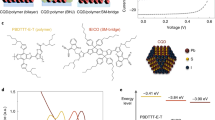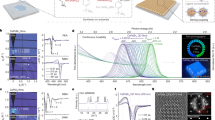Abstract
Colloidal quantum dots (CQDs) are promising photovoltaic (PV) materials because of their widely tunable absorption spectrum controlled by nanocrystal size1,2. Their bandgap tunability allows not only the optimization of single-junction cells, but also the fabrication of multijunction cells that complement perovskites and silicon3. Advances in surface passivation2,4,5,6,7, combined with advances in device structures8, have contributed to certified power conversion efficiencies (PCEs) that rose to 11% in 20169. Further gains in performance are available if the thickness of the devices can be increased to maximize the light harvesting at a high fill factor (FF). However, at present the active layer thickness is limited to ~300 nm by the concomitant photocarrier diffusion length. To date, CQD devices thicker than this typically exhibit decreases in short-circuit current (JSC) and open-circuit voltage (VOC), as seen in previous reports3,9,10,11. Here, we report a matrix engineering strategy for CQD solids that significantly enhances the photocarrier diffusion length. We find that a hybrid inorganic–amine coordinating complex enables us to generate a high-quality two-dimensionally (2D) confined inorganic matrix that programmes internanoparticle spacing at the atomic scale. This strategy enables the reduction of structural and energetic disorder in the solid and concurrent improvements in the CQD packing density and uniformity. Consequently, planar devices with a nearly doubled active layer thicknesses (~600 nm) and record values of JSC (32 mA cm−2) are fabricated. The VOC improved as the current was increased. We demonstrate CQD solar cells with a certified record efficiency of 12%.
This is a preview of subscription content, access via your institution
Access options
Access Nature and 54 other Nature Portfolio journals
Get Nature+, our best-value online-access subscription
$29.99 / 30 days
cancel any time
Subscribe to this journal
Receive 12 print issues and online access
$259.00 per year
only $21.58 per issue
Buy this article
- Purchase on Springer Link
- Instant access to full article PDF
Prices may be subject to local taxes which are calculated during checkout





Similar content being viewed by others
References
Kagan, C. R., Lifshitz, E., Sargent, E. H. & Talapin, D. V. Building devices from colloidal quantum dots. Science 353, aac5523 (2016).
Luther, J. M. et al. Schottky solar cells based on colloidal nanocrystal films. Nano Lett. 8, 3488–3492 (2008).
Ip, A. H. et al. Infrared colloidal quantum dot photovoltaics via coupling enhancement and agglomeration suppression. ACS Nano 9, 8833–8842 (2015).
Ip, A. H. et al. Hybrid passivated colloidal quantum dot solids. Nat. Nanotech. 7, 577–582 (2012).
Tang, J. et al. Colloidal-quantum-dot photovoltaics using atomic-ligand passivation. Nat. Mater. 10, 765–771 (2011).
Ning, Z. et al. Air-stable n-type colloidal quantum dot solids. Nat. Mater. 13, 822–828 (2014).
Dirin, D. N. et al. Lead halide perovskites and other metal halide complexes as inorganic capping ligands for colloidal nanocrystals. J. Am. Chem. Soc. 136, 6550–6553 (2014).
Chuang, C.-H. M., Brown, P. R., Bulović, V. & Bawendi, M. G. Improved performance and stability in quantum dot solar cells through band alignment engineering. Nat. Mater. 13, 796–801 (2014).
Liu, M. et al. Hybrid organic–inorganic inks flatten the energy landscape in colloidal quantum dot solids. Nat. Mater. 16, 258–263 (2016).
Carey, G. H., Levina, L., Comin, R., Voznyy, O. & Sargent, E. H. Record charge carrier diffusion length in colloidal quantum dot solids via mutual dot-to-dot surface passivation. Adv. Mater. 27, 3325–3330 (2015).
Lan, X. et al. 10.6% certified colloidal quantum dot solar cells via solvent-polarity-engineered halide passivation. Nano Lett. 16, 4630–4634 (2016).
Dolzhnikov, D. S. et al. Composition-matched molecular ‘solders’ for semiconductors. Science 347, 425–428 (2015).
Ning, Z. et al. Quantum-dot-in-perovskite solids. Nature 523, 324–328 (2015).
Gilmore, R. H., Lee, E. M. Y., Weidman, M. C., Willard, A. P. & Tisdale, W. A. Charge carrier hopping dynamics in homogeneously broadened PbS quantum dot solids. Nano Lett. 17, 893–901 (2017).
Guyot-Sionnest, P. Electrical transport in colloidal quantum dot films. J. Phys. Chem. Lett. 3, 1169–1175 (2012).
Akselrod, G. M. et al. Visualization of exciton transport in ordered and disordered molecular solids. Nat. Commun. 5, 4646 (2014).
Chuang, C.-H. M. et al. Open-circuit voltage deficit, radiative sub-bandgap states, and prospects in quantum dot solar cells. Nano Lett. 15, 3286–3294 (2015).
Blancon, C. Extremely efficient internal exciton dissociation through edge states in layered 2D perovskites. Science 355, 1288–1292 (2017).
Congreve, D. N. et al. Tunable light-emitting diodes utilizing quantum-confined layered perovskite emitters. ACS Photonics 4, 476–481 (2017).
Zhang, J. et al. Layered ultrathin PbI2 single crystals for high sensitivity flexible photodetectors. J. Mater. Chem. C 3, 4402–4406 (2015).
Derenzo, S. E. et al. Experimental and theoretical studies of donor–acceptor scintillation from PbI2. J. Lumin. 134, 28–34 (2013).
Cooper, J. K., Franco, A. M., Gul, S., Corrado, C. & Zhang, J. Z. Characterization of primary amine capped CdSe, ZnSe, and ZnS quantum dots by FT-IR: determination of surface bonding interaction and identification of selective desorption. Langmuir 27, 8486–8493 (2011).
Sayevich, V. et al. Hybrid N-butylamine-based ligands for switching the colloidal solubility and regimentation of inorganic-capped nanocrystals. ACS Nano 11, 1559–1571 (2017).
Anderson, N. C., Hendricks, M. P., Choi, J. J. & Owen, J. S. Ligand exchange and the stoichiometry of metal chalcogenide nanocrystals: spectroscopic observation of facile metal-carboxylate displacement and binding. J. Am. Chem. Soc. 135, 18536–18548 (2013).
Barrit, D. et al. Hybrid perovskite solar cells: in situ investigation of solution-processed PbI2 reveals metastable precursors and a pathway to producing porous thin films. J. Mater. Res. 32, 1899–1907 (2017).
Munir, R. et al. Hybrid perovskite thin-film photovoltaics: in situ diagnostics and importance of the precursor solvate phases. Adv. Mater. 29, 1604113 (2017).
Akselrod, G. M. et al. Subdiffusive exciton transport in quantum dot solids. Nano Lett. 14, 3556–3562 (2014).
Sandeep, C. S. S. et al. Epitaxially connected PbSe quantum-dot films: controlled neck formation and optoelectronic properties. ACS Nano 8, 11499–11511 (2014).
Murray, C. B., Kagan, C. R. & Bawendi, M. G. Synthesis and characterization of monodisperse nanocrystals and close-packed nanocrystal assemblies. Annu. Rev. Mater. Sci. 30, 545–610 (2000).
Hanrath, T., Choi, J. J. & Smilgies, D.-M. Structure/processing relationships of highly ordered lead salt nanocrystal superlattices. ACS Nano 3, 2975–2988 (2009).
Rolland, A., Richard, J., Kleider, J. P. & Mencaraglia, D. Electrical properties of amorphous silicon transistors and MIS‐devices: comparative study of top nitride and bottom nitride configurations. J. Electrochem. Soc. 140, 3679–3683 (1993).
Zhitomirsky, D., Voznyy, O., Hoogland, S. & Sargent, E. H. Measuring charge carrier diffusion in coupled colloidal quantum dot solids. ACS Nano 7, 5282–5290 (2013).
Choi, J. J. et al. Photogenerated exciton dissociation in highly coupled lead salt nanocrystal assemblies. Nano Lett. 10, 1805–1811 (2010).
Makarov, N. S. et al. Spectral and dynamical properties of single excitons, biexcitons, and trions in cesium–lead-halide perovskite quantum dots. Nano Lett. 16, 2349–2362 (2016).
Park, Y.-S., Bae, W. K., Pietryga, J. M. & Klimov, V. I. Auger recombination of biexcitons and negative and positive trions in individual quantum dots. ACS Nano 8, 7288–7296 (2014).
Acknowledgements
This publication is based in part on work supported by the Natural Sciences and Engineering Research Council of Canada, by the Ontario Research Fund Research Excellence Program and by Award OSR-2017-CPF-3321-03 made by King Abdullah University of Science and Technology (KAUST). Some of the GIWAXS/GISAXS measurements were performed at the Cornell High Energy Synchrotron Source (CHESS), supported by the NSF Award DMR-1332208. This work also made use of the South Carolina SAXS Collaborative using a SAXSLab Ganesha for the GISAXS/GIWAXS measurements, supported by the NSF Major Research Instrumentation program (award no. DMR-1428620). We thank U. Jeng for the GIWAXS tested at the National Synchrotron Radiation Research Center, Taiwan, China. We thank L. Goncharova for assistance with RBS measurements. We thank D. Kopilovic, E. Palmiano, L. Levina and R. Wolowiec for the technical support.
Author information
Authors and Affiliations
Contributions
J.X. conceived the idea and contributed to most experimental work. E.H.S. supervised the project. O.V., A.A. and S.O.K. co-supervised the project. Mengxia Liu assisted in the device fabrication and experiment design. S.H. assisted in the devices certificate and experiment design. A.R.K., M.A. and A.A. performed the in situ measurements of film formation. R.M., M.S., A.S. and R.Q.B. carried out the GISAXS/WAXS measurements. G.W. and M.W. performed the AFM and PL measurements. A.H.P. performed the TA measurements. B.S. carried out the FET measurements. O.V. and O.O. carried out the device simulations. Min Liu carried out microscopic studies. O.V. facilitated the RBS analysis. J.X., O.V. and E.H.S. wrote the manuscript. All the authors assisted in the experiments and provided comments on the text.
Corresponding authors
Ethics declarations
Competing interests
The authors declare no competing interests.
Additional information
Publisher’s note: Springer Nature remains neutral with regard to jurisdictional claims in published maps and institutional affiliations.
Supplementary information
Supplementary Information
Supplementary Figures 1–24, Supplementary references
Rights and permissions
About this article
Cite this article
Xu, J., Voznyy, O., Liu, M. et al. 2D matrix engineering for homogeneous quantum dot coupling in photovoltaic solids. Nature Nanotech 13, 456–462 (2018). https://doi.org/10.1038/s41565-018-0117-z
Received:
Accepted:
Published:
Issue Date:
DOI: https://doi.org/10.1038/s41565-018-0117-z
This article is cited by
-
Dry Transfer Printed Hole Transport Layer for Hysteresis-Free Colloidal Quantum Dot Solar Cells
International Journal of Precision Engineering and Manufacturing-Green Technology (2024)
-
Efficient quantum dot infrared solar cells with enhanced low-energy photon conversion via optical engineering
Nano Research (2023)
-
How to get high-efficiency lead chalcogenide quantum dot solar cells?
Science China Physics, Mechanics & Astronomy (2023)
-
Perovskite bridging PbS quantum dot/polymer interface enables efficient solar cells
Nano Research (2022)
-
Vapor phase epitaxy of PbS single-crystal films on water-soluble substrates and application to photodetectors
Nano Research (2022)



